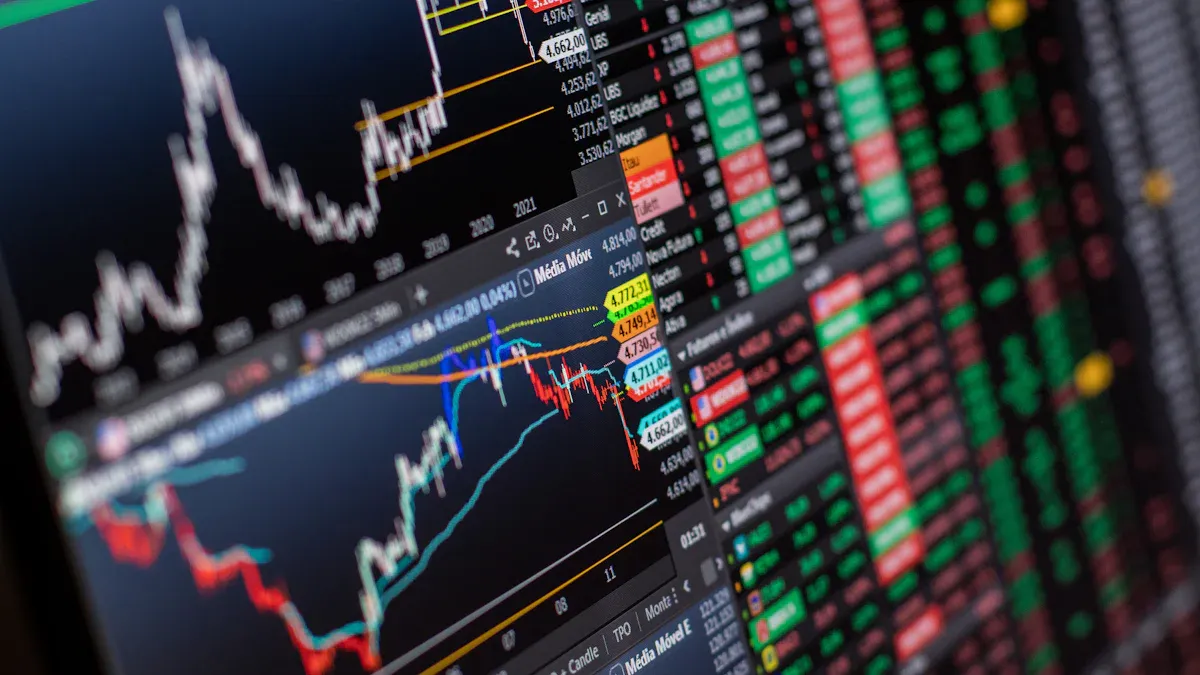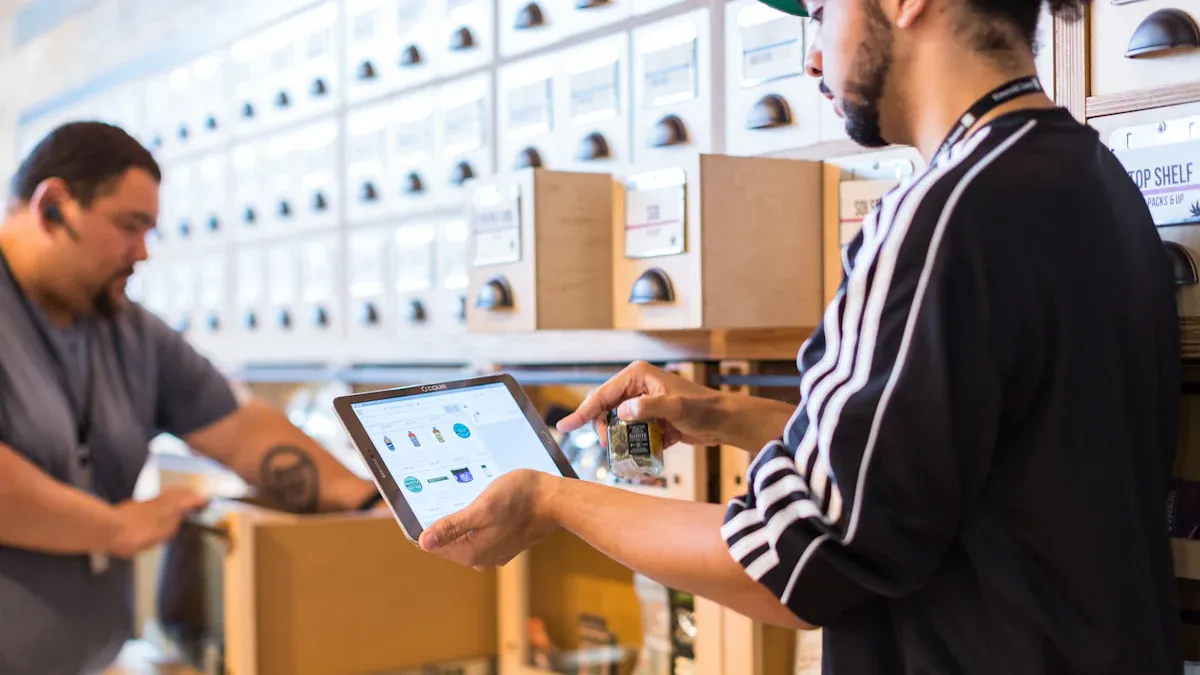Real-time stock monitoring ai in stores

Imagine you walk into your favorite store and find empty shelves where your go-to products should be. This frustration happens when inventory runs low or gets mismanaged. You face long waits or leave empty-handed, and stores lose sales. Real-time stock monitoring gives you and retailers a better experience. Retailers using AI have seen logistics costs drop by 15%, inventory levels fall by 35%, and service levels improve by 65%. With this technology, you enjoy well-stocked shelves while retailers manage inventory with greater accuracy.
Key Takeaways
Real-time stock monitoring improves inventory management, reducing logistics costs by 15% and inventory levels by 35%.
AI and IoT technologies automate restocking, ensuring shelves are always full and enhancing customer satisfaction.
Predictive tools help stores forecast demand accurately, minimizing stockouts and waste while optimizing inventory levels.
Integration with POS and warehouse systems allows for instant updates on stock levels, improving operational efficiency.
Investing in real-time stock monitoring can lead to significant cost savings and a strong return on investment within one to three years.
Real-time stock monitoring system

How it works
You see real-time stock monitoring in action when stores use AI, IoT sensors, and automated replenishment to track inventory every second. AI models watch what shoppers do, like which items they pick up or leave behind. IoT sensors, such as RFID tags and Bluetooth beacons, send instant updates about product locations. Automated systems use this data to restock shelves before items run out. When you buy something, the system records the sale and checks if the shelf needs refilling. If stock gets low, the system can order more products automatically. This process keeps shelves full and helps stores avoid overstock.
Tip: Real-time stock monitoring helps stores respond quickly to changes in customer demand, so you always find what you need.
Data collection
Stores collect data from many sources to make real-time stock monitoring work. Cameras and motion sensors track how many people enter and leave the store. These devices also notice which products shoppers pick up and how they move around. RFID tags and computer vision systems help stores know exactly where each item is. Wiliot's IoT Pixels use radio waves to send real-time data about products. All this information goes to powerful computers called GPUs, which process it fast. Stores use cloud access to save and analyze this data.
Here is a table showing the main components that collect data in stores:
Component | Description |
|---|---|
Customer Traffic Analysis | Analyzes the number of customers entering and exiting the store. |
Staff Performance | Evaluates how effectively staff are assisting customers. |
Customers Behaviour | Observes customer interactions for future recommendations. |
Person Detection | Identifies shoppers based on their shopping carts. |
Object Recognition | Recognizes items taken by shoppers. |
Pose Estimation | Detects shoppers' movements regarding their items. |
Motion Sensors and Camera Feed | Collaborates with cameras and motion sensors to make informed decisions. |
Streaming Services | Utilizes high-quality cameras for live streaming store activities. |
The Motion Sensors | Triggers activities based on unusual behavior. |
Access to GPUs | Requires high-capacity GPUs for real-time machine learning processing. |
Cloud Access | Necessary for storing model artifacts and data. |
Integration with store systems
You benefit from real-time stock monitoring because it connects with point-of-sale (POS) and warehouse management systems. When you buy something, the POS system updates inventory levels right away. The system also works with online sales channels, so stores know exactly how much stock they have everywhere. Advanced technologies like IoT make these updates fast and accurate. If an item moves from the warehouse to the store, the system records the change instantly.
Stores use these integration methods:
Brick-and-mortar POS systems update inventory after each sale.
Ecommerce POS systems track online purchases and adjust stock.
Warehouse management systems monitor product movement and storage.
This integration helps stores keep track of products across all locations. AI algorithms use predictive analytics to forecast future needs by looking at past sales and customer behavior. Automated replenishment systems use this information to order new stock when needed. Real-time alerts tell store managers if something unusual happens, like a sudden drop in inventory. You get better service because stores always know what products are available.
Note: Real-time stock monitoring improves operational efficiency and helps stores avoid mistakes in inventory management.
Key technologies

IoT and RFID
You see IoT devices and RFID tags working together to give stores instant updates about every product. RFID tags attach to items and send signals to sensors, so you always know what is on the shelf. Stores use these tags to automate restocking and keep shelves full. You benefit because RFID speeds up order processing and makes shopping smoother. The table below shows how RFID technology helps stores manage inventory:
Evidence Type | Description |
|---|---|
Effortless Replenishment Procedures | RFID systems automate replenishment, reducing manual checks and ensuring stock availability. |
Accelerated Order Fulfillment | RFID provides real-time inventory visibility, speeding up order processing and improving accuracy. |
Boosting Shelf Availability | Continuous monitoring of shelf inventory helps maintain stock levels and enhances customer experience. |
Fine-tuning Supply Chain Visibility | Real-time tracking through RFID improves logistics and identifies bottlenecks in the supply chain. |
AI-enabled shelves use sensors to track perishable goods. You get fresher products because these shelves alert staff when items need restocking or when food is close to expiring. Smart shelves can even show dynamic prices based on freshness.
Cloud analytics
Cloud analytics platforms help stores process huge amounts of inventory data. You see the benefits when stores use AI-driven forecasting to adjust inventory based on real-time demand. These platforms automate replenishment and optimize supply chains. Stores predict demand shifts by analyzing weather and promotions. Live stock tracking prevents overselling and understocking. Instant synchronization across locations keeps inventory accurate, unlike old systems that update slowly.
AI-driven forecasting adjusts inventory strategies using real-time demand signals.
Automated replenishment optimizes supply chains.
Demand prediction prevents stockouts by analyzing factors like weather and promotions.
Live tracking with automated updates prevents overselling and understocking.
Instant synchronization across locations ensures accurate inventory management.
Predictive tools
Predictive tools help stores forecast inventory needs and avoid running out of popular items. You benefit because stores use live data to set the best reorder points and quantities. These tools minimize excess stock and reduce waste. The table below lists some top predictive software:
Software | Key Features |
|---|---|
GMDH Streamline | Data-driven forecasting, advanced analytics, real-time reporting capabilities |
Relex | Advanced demand forecasting, real-time inventory tracking, seamless integration with existing systems |
SmartForecasts | Demand planning, safety stock optimization, real-time reporting |
Stores use predictive analytics to adjust stock levels, spot overstock, and monitor supplier performance. You get better products because stores can fix problems before they happen. For example, a grocery chain saved $30,000 by repairing a freezer before it failed. Restaurants avoid fines by getting alerts about cooler temperatures. Teams prevent breakdowns by watching energy use in refrigerators.
Tip: Predictive tools help stores keep shelves stocked and fresh, so you always find what you need.
Benefits for retailers
Inventory accuracy
You gain better control over your inventory when you use real-time stock monitoring. This technology helps you reduce mistakes and keep your stock levels correct. AI checks your inventory against sales data all the time. You spot problems quickly and fix them before they grow. You also improve your demand forecasting, so you know what to order and when. The table below shows how these improvements work:
Improvement Type | Description |
|---|---|
Reduction in Stock Discrepancies | AI algorithms continuously monitor inventory levels against sales data to minimize discrepancies. |
Enhanced Demand Forecasting | AI improves the accuracy of demand forecasting, leading to better inventory management. |
You can use tools like OneTruth by OnePint.ai to keep your stock accurate across all your sales channels. Phantom Inventory by invent.ai helps you find and fix errors in your inventory data. These solutions make your inventory more reliable and help you avoid costly mistakes.
Cost savings
You save money with real-time stock monitoring because you avoid buying too much or too little. AI watches demand signals and helps you adjust your orders quickly. You do not need to rush emergency orders, which often cost more. You also cut down on storage costs by only keeping what you need. Here are some ways you save:
AI senses demand in real time, so you adjust inventory before problems start.
Predictive forecasting tells you what to order, reducing last-minute purchases.
AI models lead time, so you order early and avoid running out.
You track inventory live, which helps you avoid overstock and extra storage fees.
You buy only what you need, freeing up space and money.
Instant stock visibility helps you restock faster and avoid delays.
Automated monitoring cuts down on errors and labor costs.
You spot slow-moving products and change your buying plans to save money.
When you use real-time stock monitoring, you see a strong return on investment. Many retailers report payback in one to three years, with annual returns often over 100%. You start seeing improvements in your key numbers within six to twelve months.
Metric | Value/Description |
|---|---|
Typical ROI Target | Positive ROI significantly exceeding cost of capital |
Payback Period | 1-3 years |
Annual Returns | Often well over 100% |
Initial Improvement Timeline | 6-12 months for measurable KPI improvements |
Customer satisfaction
You keep your customers happy when you always have what they want on the shelf. Real-time stock monitoring helps you avoid empty shelves and long waits. Your customers find their favorite products and enjoy a smooth shopping trip. This leads to higher satisfaction scores and more repeat visits. The On-Shelf Availability Rate (OSR) shows how well you keep products available. High OSR means your customers trust your store and come back again.
Real-time stock monitoring also helps your staff give better service. They know what is in stock and can answer customer questions quickly. You reduce mistakes and make shopping easier for everyone.
Tip: Happy customers spend more and tell their friends about your store.
Efficiency
You make your store run better when you use real-time stock monitoring. Your staff spends less time counting products and more time helping customers. Automation handles routine tasks, so you focus on what matters most. You see all your inventory data in one place, which helps you make smart decisions fast. The table below shows how your operations improve:
Benefit | Impact on Operational Efficiency |
|---|---|
Enables staff to know what needs reordering and what does not. | |
Automation of routine tasks | Reduces time spent on manual inventory reconciliation. |
Proactive inventory controls | Allows for quicker strategic decision-making. |
Streamlined operations | Enhances overall productivity and customer satisfaction. |
You also get better supply chain visibility. Real-time stock monitoring gives you instant access to inventory data across all your stores. You respond quickly to changes in demand and avoid both stockouts and overstocks. Centralized systems keep your sales, stock, and orders in sync. You cut down on manual errors and make your workflows smoother.
Note: When you use real-time stock monitoring, you transform your inventory management and boost your store’s performance.
Implementation challenges
Barriers
You may face several obstacles when you try to bring AI into your store for inventory tracking. Many stores still use manual inventory tracking, which can lead to mistakes and slow updates. Inaccurate demand forecasting makes it hard to know what customers want, so you might order too much or too little. Limited visibility into your supply chain can keep you from seeing where products are at any moment.
Barrier | Description |
|---|---|
Inaccurate demand forecasting | Difficulty in predicting customer demand accurately, leading to stock issues. |
Manual inventory tracking | Reliance on manual processes that can be error-prone and inefficient. |
Limited visibility into supply chain | Lack of real-time insights into stock levels and supply chain status. |
You may also run into problems with older systems. These legacy systems often do not work well with new AI tools. Compatibility issues can slow down your progress. Sometimes, your current systems cannot handle the large amounts of data that AI needs. Your staff may feel unsure about using new technology, and the cost of upgrading can seem high.
Compatibility issues with legacy systems make integration difficult.
Scalability constraints limit how much data you can process.
Workforce adaptation takes time as staff learn new skills.
Financial uncertainties make it hard to plan for the future.
Solutions
You can overcome these barriers with the right strategies. Start by choosing AI tools that fit your store’s needs and follow data privacy laws. Make sure your system can process data in real time. Train your staff with programs that match their roles, such as warehouse workers or managers. Change management helps your team see the benefits of new tools.
Key Consideration | Description |
|---|---|
AI Tool Selection | Balance advanced features with practical implementation needs. |
Ensure the tool provides real-time data processing capabilities. | |
Compliance | The tool must comply with domestic data privacy laws. |
Training Strategy | Purpose |
|---|---|
Equip staff with the skills to use AI tools effectively. | |
Role-specific Training | Ensure smooth adoption for different roles (warehouse, managers, etc.). |
Change Management | Improve adoption by explaining the benefits of AI tools. |
You can also keep your team updated with ongoing training and open discussions. Create feedback channels so staff can share ideas and concerns. This helps everyone work together and solve problems faster.
Case studies
Many grocery and retail stores have already seen success with these solutions. One grocery chain reduced perishable waste by 37% using AI-powered demand forecasting. Another store saw a 32% drop in stockouts, so customers found what they needed more often. Forecast accuracy improved by 27% when stores combined historical trends with real-time data. Some stores even grew their revenue by 12% after optimizing inventory.
You can learn from these examples. AI can predict demand for specific products and locations, which helps you plan better. High-quality data and practical solutions, like data standardization and API integration, make your system more accurate. When you focus on these lessons, you set your store up for long-term success.
You see big changes when you use AI for inventory management. AI algorithms study past sales and outside factors to help you predict demand. This means you avoid running out of products and keep shelves full. You also fix mistakes faster and make customers happier.
Impact Area | Measurable Effect |
|---|---|
Fulfillment Errors | 35% reduction in errors |
Customer Satisfaction | Significant improvements reported |
Stock Discrepancies | Immediate identification and resolution |
Stock Levels | Optimal maintenance with reduced risks |
To get started, you should:
Assess your current inventory systems.
Test integration early.
Start with a pilot program.
Define clear success metrics.
Scale to full system implementation.
Take action now. You can improve your store’s performance and set up long-term success.
FAQ
What is real-time stock monitoring AI?
You use real-time stock monitoring AI to track inventory instantly. The system uses sensors and smart software. It helps you know what is on the shelf at any moment.
How does AI help prevent stockouts?
AI checks sales and inventory data all the time. It alerts you when stock gets low. You can reorder products before you run out.
Is it hard to set up real-time stock monitoring in my store?
You can start with a pilot program. Many systems work with your current tools. Training helps your team learn quickly.
What are the main benefits for customers?
Customers find products in stock more often. Shopping becomes faster and easier. Staff can help you better because they know what is available.
Can small stores use this technology?
Yes! Many solutions fit small stores. You can choose simple systems that grow with your business.
See Also
The Future of Retail Lies in AI-Driven Stores
Transforming Online Retail Management with AI E-Commerce Solutions
Essential Insights for Retailers on AI-Enhanced Corner Stores
Launching a Cost-Effective AI-Driven Corner Store Successfully
